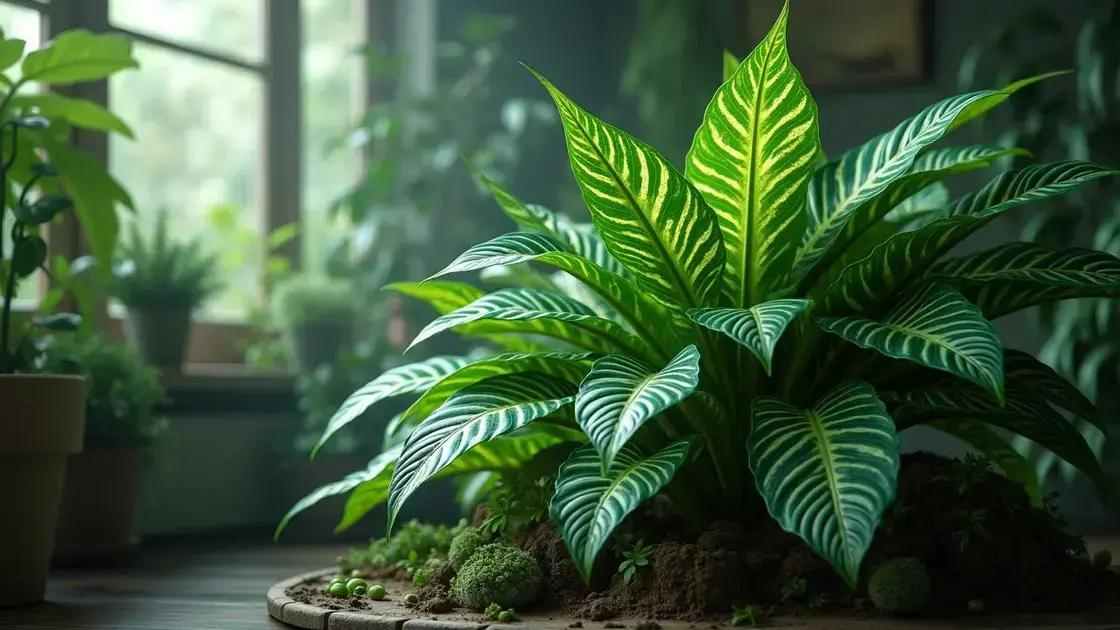How to Care for Dieffenbachia Plant: 5 Essential Tips for Thriving Growth
How to care for dieffenbachia plant effectively can transform it from ordinary to extraordinary. Each leaf tells a story of growth, but achieving that involves understanding the nuances of its care. With just a few simple guidelines, your dieffenbachia can thrive and bring life to your space. Let’s explore some key aspects to nurture your green friend.
Table of Contents
ToggleOptimal soil requirements for your dieffenbachia
Optimal soil requirements for your dieffenbachia are essential for ensuring healthy growth and vibrant foliage. Dieffenbachia plants thrive in well-draining, rich soil that retains moisture without becoming soggy. Choosing the right soil mix can significantly affect the plant’s overall health, making it crucial for any Dieffenbachia owner to understand their needs.
Here are some key points to consider when selecting the perfect soil for your dieffenbachia:
- Soil composition: A good mix typically includes potting soil, peat moss, and perlite. This combination allows for adequate drainage while retaining necessary moisture.
- pH level: Dieffenbachia prefers slightly acidic to neutral soil, with a pH range of 5.5 to 7.0. Testing soil pH can help ensure optimal growth.
- Drainage: Ensure that your pot has drainage holes and avoid water-logged conditions. Adding materials like perlite or coarse sand can enhance drainage.
Mixing your own soil for dieffenbachia
If you prefer a DIY approach, you can easily create your own soil mix:
- Combine equal parts of potting soil, peat moss, and perlite.
- Test the mixture for moisture retention by adding water and observing drainage.
- Adjust ratios as needed to achieve your desired consistency.
Providing the right soil conditions is just one part of the equation. Remember, regular maintenance plays a crucial role in achieving a lush dieffenbachia.
For those interested in exploring indoor gardening techniques, understanding soil requirements is fundamental to success.
For new plant parents, start with high-quality commercial potting mixes designed for houseplants. These often contain slow-release fertilizers, which can further support your dieffenbachia’s growth.
Essential watering schedule for dieffenbachia care

Essential watering schedule for dieffenbachia care plays a critical role in maintaining its health and vibrancy. These beautiful plants thrive in environments where their watering needs are carefully monitored.
Understanding when and how much to water your dieffenbachia can prevent issues like overwatering or drought stress. Here’s an overview of the watering schedule:
General watering guidelines
- Water when the top 1-2 inches of soil feels dry.
- In warmer months, typically every 7-10 days is ideal.
- In winter, reduce watering frequency to every 2-3 weeks.
It’s essential to adjust your watering schedule based on the environmental conditions of your home. Factors like temperature and humidity can affect how quickly the soil dries out.
Signs your dieffenbachia needs water
- Drooping leaves are a common indicator of dehydration.
- Yellowing leaves can signify overwatering or poor drainage.
- Check for crispy leaf edges as a warning of underwatering.
For those who are exploring indoor gardening techniques, maintaining the right watering schedule is crucial.
Best practices for watering
- Use room temperature water to avoid shocking the plant.
- Ensure excess water drains out by using pots with drainage holes.
- Consider misting the leaves occasionally to increase humidity.
Keep in mind that dieffenbachia are sensitive to chlorine and fluoride found in tap water. If possible, use filtered or distilled water for the best results.
How sunlight exposure impacts dieffenbachia growth
How sunlight exposure impacts dieffenbachia growth is crucial for any plant enthusiast. Dieffenbachia, with its stunning foliage, relies on the right amount of sunlight to thrive.
Providing optimal sunlight conditions can enhance leaf color and growth rate, making understanding this aspect essential.
Ideal sunlight conditions for dieffenbachia
- Bright, indirect light is preferred to avoid leaf burn.
- Avoid placing the plant in direct sunlight for extended periods.
- Low light conditions can lead to leggy growth and poor health.
Experimenting with lighting conditions helps determine the best spot for your dieffenbachia in your indoor space. Regularly observing the plant will guide adjustments as needed.
Effects of insufficient sunlight
- Yellowing leaves may indicate that the plant isn’t receiving enough light.
- Slower growth rates can be a sign of insufficient sunlight exposure.
- Leaves may drop prematurely in low-light conditions.
For a more robust understanding of plant care, exploring indoor gardening techniques can provide valuable insights.
Enhancing sunlight exposure
- Position your dieffenbachia near east or west-facing windows for optimal light.
- Rotate the plant occasionally to promote even growth.
- Use sheer curtains to diffuse harsh sunlight when needed.
By paying attention to these sunlight exposure guidelines, you can significantly enhance the growth and beauty of your dieffenbachia, ensuring it remains a vibrant centerpiece in your living space.
In conclusion
Caring for dieffenbachia requires attention to several key factors, including optimal soil requirements, a proper watering schedule, and appropriate sunlight exposure. By following the guidelines outlined in this article, you can ensure that your dieffenbachia thrives and continues to beautify your indoor space. For those seeking further knowledge, consider checking out tips on enhancing your indoor garden, which can provide additional insights into nurturing your plants effectively.

